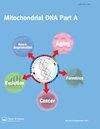Massive parallel sequencing of human whole mitochondrial genomes with Ion Torrent technology: an optimized workflow for Anthropological and Population Genetics studies
IF 0.6
4区 生物学
Q4 GENETICS & HEREDITY
引用次数: 5
Abstract
Abstract Investigation of human mitochondrial DNA variation patterns and phylogeny has been extensively used in Anthropological and Population Genetics studies and sequencing the whole mitochondrial genome is progressively becoming the gold standard. Among the currently available massive parallel sequencing technologies, Ion Torrent™ semiconductor sequencing represents a promising approach for such studies. Nevertheless, an experimental protocol conceived to enable the achievement of both as high as possible yield and of the most homogeneous sequence coverage through the whole mitochondrial genome is still not available. The present work was thus aimed at improving the overall performance of whole mitochondrial genomes Ion Torrent™ sequencing, with special focus on the capability to obtain robust coverage and highly reliable variants calling. For this purpose, a series of cost-effective modifications in standard laboratory workflows was fine-tuned to optimize them for medium- and large-scale population studies. A total of 54 human samples were thus subjected to sequencing of the whole mitochondrial genome with the Ion Personal Genome Machine™ System in four distinct experiments and using Ion 314 chips. Seven of the selected samples were also characterized by means of conventional Sanger sequencing for the sake of comparison. Obtained results demonstrated that the implemented optimizations had definitely improved sequencing outputs in terms of both variants calling efficiency and coverage uniformity, enabling to setup an effective and accurate protocol for whole mitochondrial genome sequencing and a considerable reduction in experimental time consumption and sequencing costs.用离子激流技术对人类全线粒体基因组进行大规模平行测序:人类学和种群遗传学研究的优化工作流程
人类线粒体DNA变异模式和系统发育的研究已广泛应用于人类学和群体遗传学研究,全线粒体基因组测序正逐渐成为金标准。在目前可用的大规模并行测序技术中,Ion Torrent™半导体测序代表了这类研究的一种有前途的方法。然而,一种旨在实现尽可能高的产量和通过整个线粒体基因组实现最均匀序列覆盖的实验方案仍然不可用。因此,目前的工作旨在提高全线粒体基因组Ion Torrent™测序的整体性能,特别关注获得强大覆盖和高度可靠的变体调用的能力。为此,对标准实验室工作流程进行了一系列具有成本效益的修改,以优化它们,以适应中型和大规模的人口研究。因此,共有54份人类样本在四个不同的实验中使用Ion Personal genome Machine™System对整个线粒体基因组进行测序,并使用Ion 314芯片。为了便于比较,所选样本中的7个也通过常规桑格测序进行了表征。得到的结果表明,所实施的优化在效率和覆盖均匀性两方面都明显提高了测序输出,能够建立有效和准确的全线粒体基因组测序方案,并大大降低了实验耗时和测序成本。
本文章由计算机程序翻译,如有差异,请以英文原文为准。
求助全文
约1分钟内获得全文
求助全文
来源期刊

Mitochondrial Dna Part a
Biochemistry, Genetics and Molecular Biology-Genetics
CiteScore
3.00
自引率
0.00%
发文量
6
期刊介绍:
Mitochondrial DNA Part A publishes original high-quality manuscripts on physical, chemical, and biochemical aspects of mtDNA and proteins involved in mtDNA metabolism, and/or interactions. Manuscripts on cytosolic and extracellular mtDNA, and on dysfunction caused by alterations in mtDNA integrity as well as methodological papers detailing novel approaches for mtDNA manipulation in vitro and in vivo are welcome. Descriptive papers on DNA sequences from mitochondrial genomes, and also analytical papers in the areas of population genetics, phylogenetics and human evolution that use mitochondrial DNA as a source of evidence for studies will be considered for publication. The Journal also considers manuscripts that examine population genetic and systematic theory that specifically address the use of mitochondrial DNA sequences, as well as papers that discuss the utility of mitochondrial DNA information in medical studies and in human evolutionary biology.
 求助内容:
求助内容: 应助结果提醒方式:
应助结果提醒方式:


